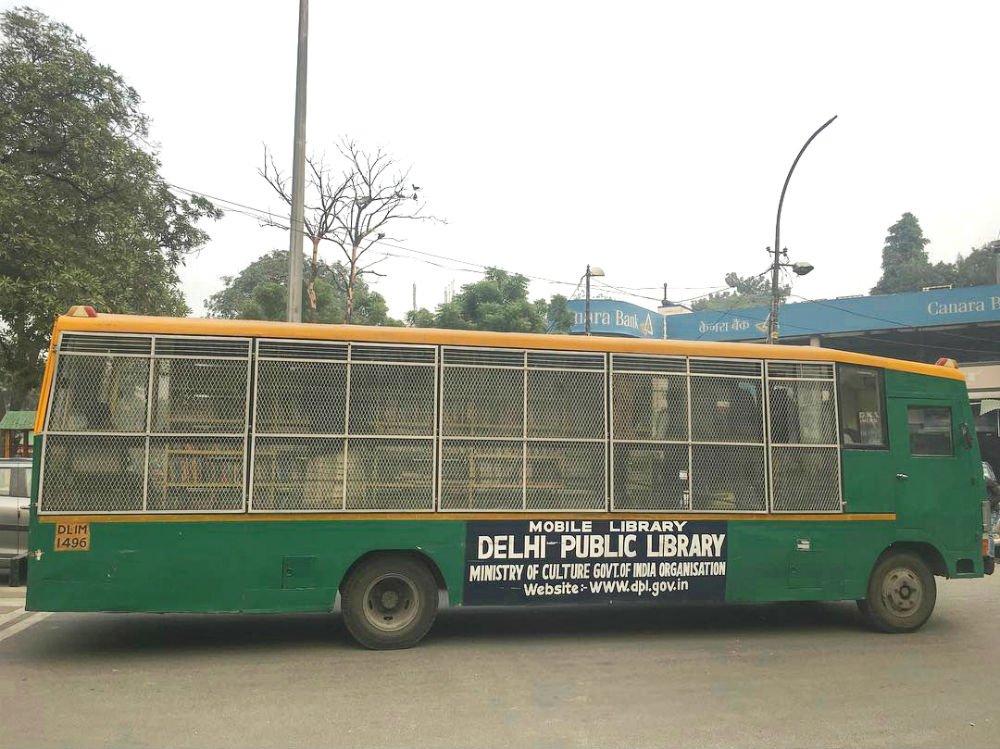The metropolis of Delhi is in the news these days for more bad reasons than good, but no matter how much you might hate it — its enriched culture and heritage cannot be denied.
Delhi has great historical significance as it was home to powerful people, such as the Pāṇḍavas and the Mughals. From the bustling marketplaces to the scrumptious ‘Dilli ki chaat’, the capital city of India is the heart of our civilization. But powering through the streets of Delhi for nearly 70 years now are the little-known and charming travelling libraries – keeping literature alive in the city.
The Delhi Public Library has been operating quaint bus libraries, or ‘chalti phirti libraries’, which were once so popular that government had to appoint security to manage huge crowds.
The Ministry Of Culture started this mobile library service back in 1953 to cater to rural areas and new colonies of Delhi due to the expansion of the city– now, this library on wheels travels across Delhi, boasting a varied collection of books. At present, the Delhi Public Library operates 7 Mobile Vans in 70 areas in the National Capital Territory in Delhi, with 6,169 registered members availing of the services. Carrying a mixed genre of books, the library covers places like Lajpat Nagar, Timar Pur, Mayur Vihar, Rohini, Vikaspuri, Malviya Nagar, Punckuyian Road, Kingsway Camp, Patparganj, Shahdra, Kapasehra, Alipur, and many other spots.
This is how these buses used to look in the 60s
1957 :: Mobile Library For Villagers
Mobile Library Was Started to Cultivate Reading Habit Among Children#WorldBookDay pic.twitter.com/we93Q6fnWq
— indianhistorypics (@IndiaHistorypic) March 4, 2021
These mobile libraries still make their scheduled rounds to various parts of the city but their overall popularity is dying. “We have gone door to door to distribute forms and gather users, but the fact is that people here already have access to reading resources.” The Indian Express quoted a librarian from the DPL.
Libraries, as we have known them all these years, are disappearing one by one across the globe. Estimates from watchdogs such as the International Federation of Library Associations and Institutions show that the number of libraries has plunged from, say, about five years ago.
In India, the public library has always been a scarce resource. According to the Ministry of Culture, there are 54,856 public libraries in India starting from English Colony Library at Chennai in 1661. But most of them are ill-maintained – buildings dilapidated and systems out of place.
Outside of academic institutions and private clubs, spaces to read and borrow books are few and far between. The country’s transition from a low-literacy, relatively poor society to a middle-income, educated one was accompanied by the rise of electronic and digital media, and we never really got to experience libraries before they became an archive.
Apart from the obvious decline in readers across the globe, there is a general consensus that one of the biggest reasons behind the death of libraries is the way funding agencies (mainly governments) refuse to dedicate money to the betterment and replenishment of libraries. In India too, the library system has been facing serious threats of late given the cuts in social sector spending and the government’s reluctance to spend on libraries. The threat is clear and present for private lending libraries as well.
There is a growing attitude among middle-class and upper-middle-class societies that tax-payer-funded libraries are redundant since they can afford to own personal copies, and have mostly switched to digital. But one of the biggest beneficiaries of libraries – the lower-middle class families who rely on public libraries for studies often don’t get a say in this matter. Libraries provide an essential service for those marginalised by society — the lonely, the unemployed, those with mobility issues, and even those with internet access issues. Not to mention the hundreds of library workers who are losing their livelihoods day by day.
The UK has seen many protests throughout the years to ensure that the government is properly funding and managing libraries – that kind of uprising is yet to be seen in India. But if we want to preserve our culture and history, we cannot let our libraries die.




